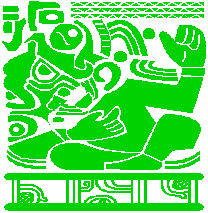![]()
Venture-Out
El Mayab (The Mayan Homeland)
to
COBÁ
Watering Place of the Grouse

L ooming in the jungle like a forlorn sentinel, the lakeside ruins of Cobá are only now beginning to concede a few of its ancient mysteries. Though heavily populated during the Spanish Colonial Period, Cobá remained undiscovered until an unheeded report made by an intrepid tourist from nearby Valladolid in 1884. The first serious notice of Cobá was made only as recently as 1974 when first surveyed by the University of Pennsylvania.
Like a huge sundial, a conical tower at the center of its city core cast shadows along 64 elaborate causeways sacbeob to mark such celestial sightings as the sunrise of the summer solstice, the sunset of the winter solstice, the northernmost moonrise, the southern minimum moonset and the Venus cycles. Situated on a huge plaza platform of almost 4 square miles, the city core of pyramids, temples and ball court maintained a metropolitan population of upwards of 70,000 people within an area of 44 square miles.
Some of the sacbeob (white ways) extended beyond the greater metropolitan limits to such sites as Ixil (11 1/2 miles distant), and Yaxuna (60 miles distant) which was first macheteed for the university's archaeologists in 1974 by attraction in itself: Jacinto, our co-guide at the site.
Thirty stone monuments (stele) have, thus far, been uncovered; the dates on one indicating Nov. 30, 780AD, Aug. 12, 3113BC and Dec. 21, 2012AD.
Recently restored, Cobá's ballcourt, built on a north-south axis, is a gem. Its panels depict Cobá's ballplayers for the especially non-prudish.
The present village of Cobá portrays the contemporary Maya whose shaman, farmers and hunters still frequent the altar at the foot of the pyramid, 'La Iglesia'. The Iglesia (Church), encountered on the east side of the main plaza, is made up of nine round-cornered levels topped with a roof comb -which, together, total 80 feet in height. On its north side there is a roofed tunnel leading to an interior vault replete with the famed 'Doorways to Nowhere'.
As impressive as the Iglesia is, the seven levels of Cobá's Nohoch Mul (Big Mound) is even loftier -the highest on the Yucatán Peninsula.
Shopper's Take Heed: Cobá's villagers offer especially low prices for their excellent handicrafts: hammocks and batiks. Mass produced T-shirts, ceramics and such are also offered at prices far lower than anywhere along the coast. All-in-all: prices which often represent savings approaching the cost of the excursion itself.
Shrouded in jungle, Cobá has been a delight for both archaeology and naturalist buffs during the twenty-year extent of Venture-Out's Definitive Excursion #1.

Thanks and: "Ka Xiik Teech Ya Utzil!"
"A teepee is a pyramid, isn't it?"
Back to Venture-Out's Main Page
To Submit Details for Quotes & Reservations:
Venture-Out's Form Page